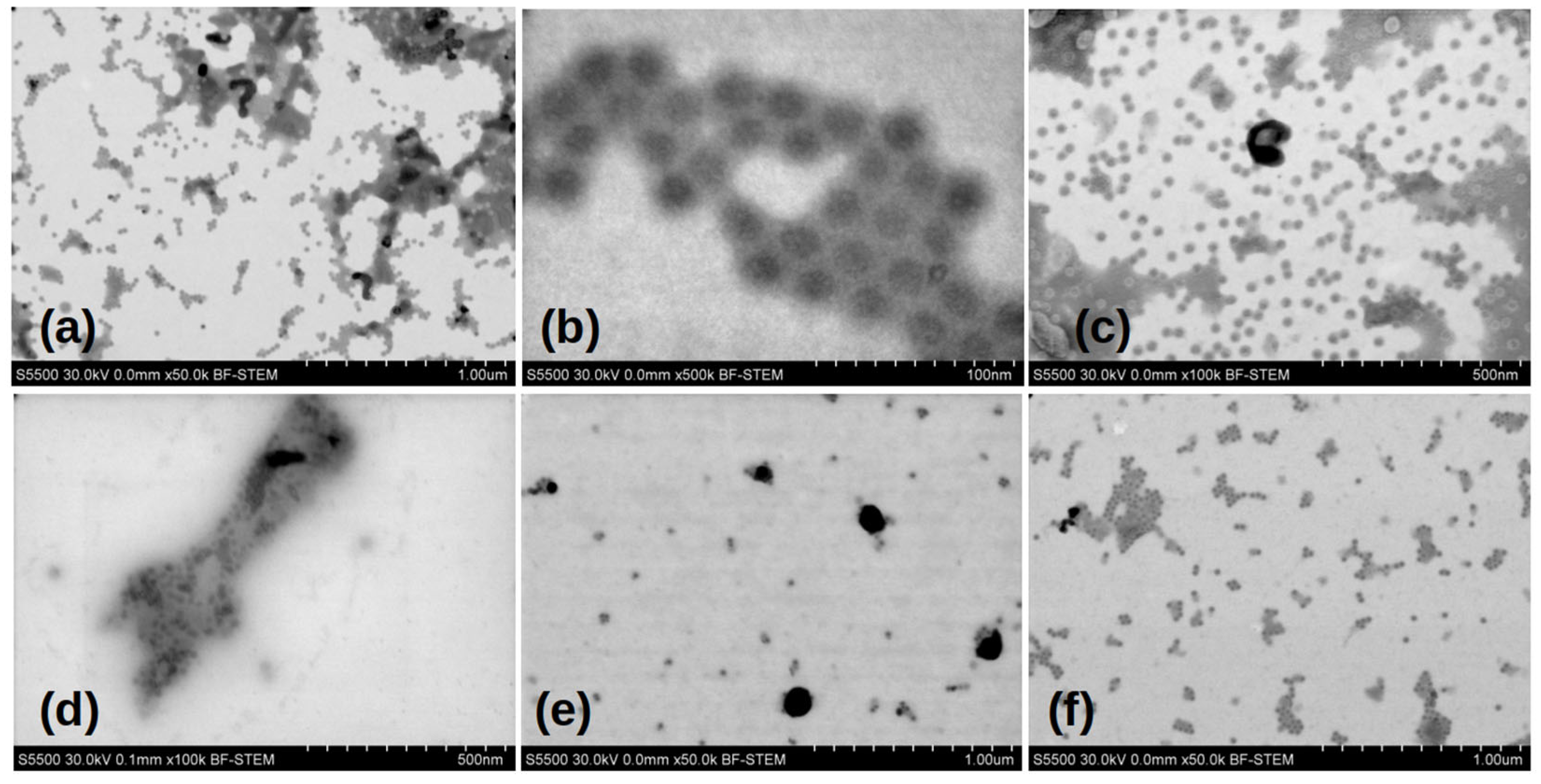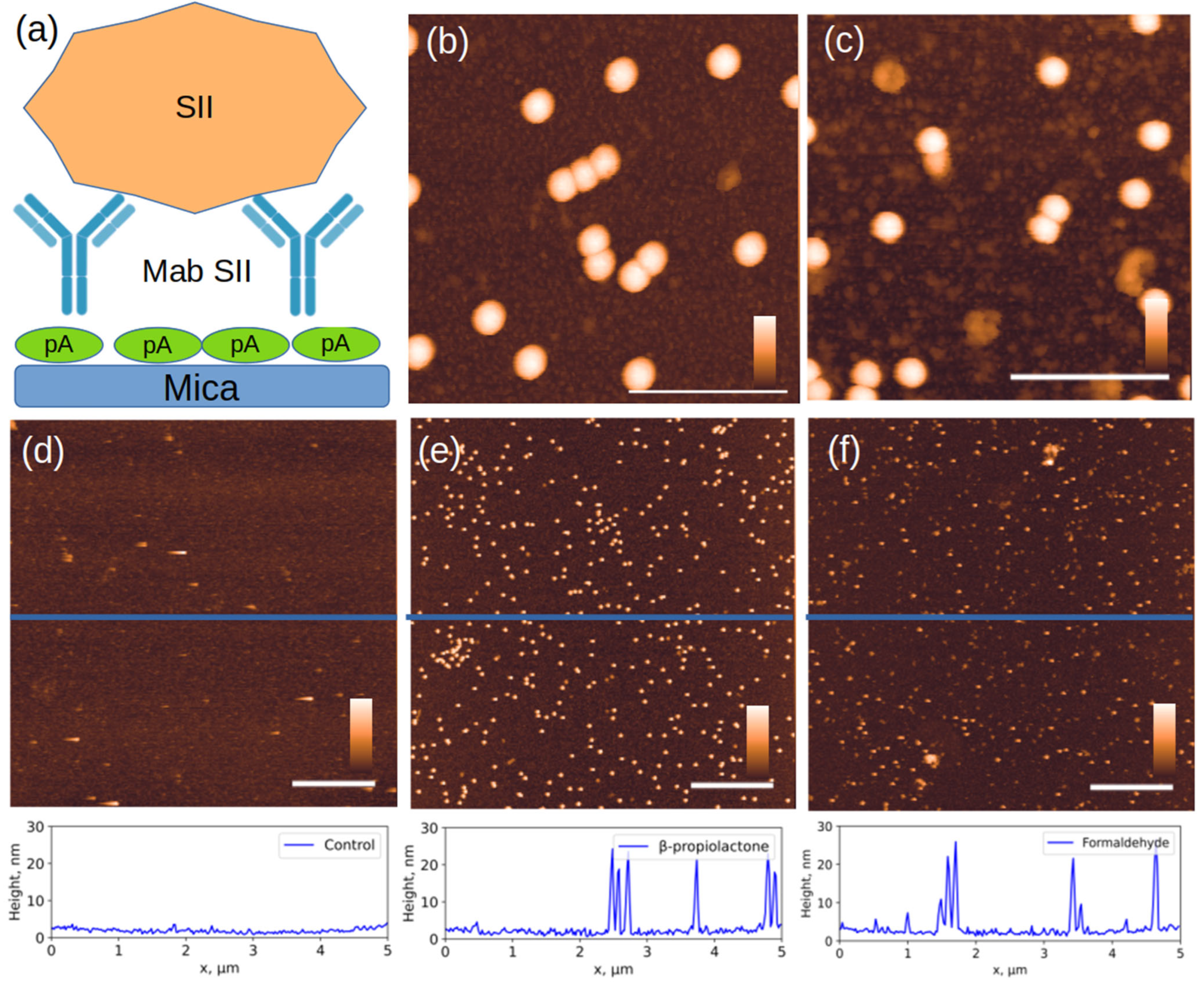Atomic Force Microscopy of Poliovirus Particles After Inactivation by Chemical Methods and Accelerated Electrons
Abstract
1. Introduction
2. Materials and Methods
2.1. Cells and Viruses
2.2. Virus Inactivation
2.3. Analysis of Residual Infectivity of Virus Samples
2.4. Determination of D-Antigen
2.5. SEM
2.6. AFM
2.7. Statistics
3. Results and Discussion
3.1. Virus Inactivation and D-Antigen Recovery
3.2. Non-Specific Immobilization
3.3. Specific Immobilization
4. Conclusions
Supplementary Materials
Author Contributions
Funding
Institutional Review Board Statement
Informed Consent Statement
Data Availability Statement
Conflicts of Interest
References
- Enterovirus. Available online: https://www.picornaviridae.com/ensavirinae/enterovirus/enterovirus.htm (accessed on 18 August 2025).
- Hogle, J.M. Poliovirus Cell Entry: Common Structural Themes in Viral Cell Entry Pathways. Annu. Rev. Microbiol. 2002, 56, 677–702. [Google Scholar] [CrossRef] [PubMed]
- Taniguchi, K.; Urasawa, S.; Urasawa, T. Electron Microscopic Examination of the Reactivity of Three Kinds of Neutralizing Antibodies with H Particles of Poliovirus. Microbiol. Immunol. 1983, 27, 645–648. [Google Scholar] [CrossRef] [PubMed]
- Rezapkin, G.; Dragunsky, E.; Chumakov, K. Improved ELISA test for determination of potency of Inactivated Poliovirus Vaccine (IPV). Biologicals 2005, 33, 17–27. [Google Scholar] [CrossRef] [PubMed]
- Le Bouvier, G.L. The D → C Change in Poliovirus Particles. Br. J. Exp. Pathol. 1959, 40, 605–620. Available online: https://pmc.ncbi.nlm.nih.gov/articles/PMC2082323/ (accessed on 18 August 2025).
- Ferguson, M.; Wood, D.J.; Minor, P.D. Antigenic structure of poliovirus in inactivated vaccines. J. Gen. Virol. 1993, 74, 685–690. [Google Scholar] [CrossRef]
- Himuma, Y.; Katagiri, S.; Aikawa, S. Immune responses to H particles of poliovirus. Virology 1970, 40, 773–776. [Google Scholar] [CrossRef]
- Our Strategy—GPEI. Available online: https://polioeradication.org/who-we-are/our-strategy/ (accessed on 18 August 2025).
- Yeh, M.T.; Smith, M.; Carlyle, S.; Konopka-Anstadt, J.L.; Burns, C.C.; Konz, J.; Andino, R.; Macadam, A. Genetic Stabilization of Attenuated Oral Vaccines against Poliovirus Types 1 and 3. Nature 2023, 619, 135–142. [Google Scholar] [CrossRef]
- Sáez-Llorens, X.; Bandyopadhyay, A.S.; Gast, C.; De Leon, T.; DeAntonio, R.; Jimeno, J.; Caballero, M.I.; Aguirre, G.; Oberste, M.S.; Weldon, W.C.; et al. Safety and immunogenicity of two novel type 2 oral poliovirus vaccine candidates compared with a monovalent type 2 oral poliovirus vaccine in children and infants: Two clinical trials. Lancet 2021, 397, 27–38. [Google Scholar] [CrossRef]
- Wang, L.; Han, W.; Li, D.; Wang, S.; Jiang, Z.; Li, Y.; Zhou, S.; Xiong, Y.; Chen, Y.; Wang, L.; et al. Immunogenicity and safety of sequential Sabin strain inactivated poliovirus vaccine from different manufacturers in infants: Randomized, blinded, controlled trial. Vaccine 2025, 61, 127448. [Google Scholar] [CrossRef]
- Van Damme, P.; De Coster, I.; Bandyopadhyay, A.S.; Revets, H.; Withanage, K.; De Smedt, P.; Suykens, L.; Oberste, M.S.; Weldon, W.C.; Costa-Clemens, S.A.; et al. The safety and immunogenicity of two novel live attenuated monovalent (serotype 2) oral poliovirus vaccines in healthy adults: A double-blind, single-centre phase 1 study. Lancet 2019, 394, 148–158. [Google Scholar] [CrossRef]
- Peak, C.M.; Lyons, H.; Voorman, A.; Gray, E.J.; Cooper, L.V.; Blake, I.M.; Hawes, K.M.; Bandyopadhyay, A.S. Monitoring the Risk of Type-2 Circulating Vaccine-Derived Poliovirus Emergence During Roll-Out of Type-2 Novel Oral Polio Vaccine. Vaccines 2024, 12, 1308. [Google Scholar] [CrossRef] [PubMed]
- Tobin, G.J.; Tobin, J.K.; Gaidamakova, E.K.; Wiggins, T.J.; Bushnell, R.V.; Lee, W.-M.; Matrosova, V.Y.; Dollery, S.J.; Meeks, H.N.; Kouiavskaia, D.; et al. A novel gamma radiation-inactivated sabin-based polio vaccine. PLoS ONE 2020, 15, e0228006. [Google Scholar] [CrossRef] [PubMed]
- Wilton, T.; Dunn, G.; Eastwood, D.; Minor, P.D.; Martin, J. Effect of Formaldehyde Inactivation on Poliovirus. J. Virol. 2014, 88, 11955–11964. [Google Scholar] [CrossRef] [PubMed]
- Zhdanov, D.; Ivin, Y.; Shishparenok, A.; Kraevskiy, S.; Kanashenko, S.; Agafonova, L.; Shumyantseva, V.; Gnedenko, O.; Pinyaeva, A.; Kovpak, A.; et al. Perspectives for the creation of a new type of vaccine preparations based on pseudovirus particles using polio vaccine as an example. Biomeditsinskaya Khimiya 2023, 69, 253–280. [Google Scholar] [CrossRef]
- Seo, H.S. Application of radiation technology in vaccines development. Clin. Exp. Vaccine Res. 2015, 4, 145–158. [Google Scholar] [CrossRef]
- Zhdanov, D.D.; Shishparenok, A.N.; Ivin, Y.Y.; Kovpak, A.A.; Piniaeva, A.N.; Levin, I.V.; Budnik, S.V.; Shilov, O.A.; Churyukin, R.S.; Agafonova, L.E.; et al. Degradation of Poliovirus Sabin 2 Genome After Electron Beam Irradiation. Vaccines 2025, 13, 824. [Google Scholar] [CrossRef]
- Grieb, T.; Forng, R.Y.; Brown, R.; Owolabi, T.; Maddox, E.; Mcbain, A.; Drohan, W.N.; Mann, D.M.; Burgess, W.H. Effective use of Gamma Irradiation for Pathogen Inactivation of Monoclonal Antibody Preparations. Biologicals 2002, 30, 207–216. [Google Scholar] [CrossRef]
- Elveborg, S.; Monteil, V.M.; Mirazimi, A. Methods of Inactivation of Highly Pathogenic Viruses for Molecular, Serology or Vaccine Development Purposes. Pathogens 2022, 11, 271. [Google Scholar] [CrossRef]
- Thomassen, Y.E.; Oever, A.G.V.; Van Oijen, M.G.C.T.; Wijffels, R.H.; A. Van Der Pol, L.; Bakker, W.A.M. Next Generation Inactivated Polio Vaccine Manufacturing to Support Post Polio-Eradication Biosafety Goals. PLoS ONE 2013, 8, e83374. [Google Scholar] [CrossRef]
- Torisu, T.; Shikama, S.; Nakamura, K.; Enomoto, K.; Maruno, T.; Mori, A.; Uchiyama, S.; Satou, T. Physicochemical Characterization of Sabin Inactivated Poliovirus Vaccine for Process Development. J. Pharm. Sci. 2021, 110, 2121–2129. [Google Scholar] [CrossRef]
- McCormick, R.A.; Ralbovsky, N.M.; Gilbraith, W.; Smith, J.P.; Booksh, K.S. Analyzing atomic force microscopy images of virus-like particles by expectation-maximization. npj Vaccines 2024, 9, 112. [Google Scholar] [CrossRef]
- Goldsmith, C.S.; Miller, S.E. Modern Uses of Electron Microscopy for Detection of Viruses. Clin. Microbiol. Rev. 2009, 22, 552–563. [Google Scholar] [CrossRef]
- Agafonova, L.; Shumyantseva, V.; Ivin, Y.; Piniaeva, A.; Kovpak, A.; Ishmukhametov, A.; Budnik, S.; Churyukin, R.; Zhdanov, D.; Archakov, A. Electrochemical profiling of poliovirus particles inactivated by chemical method and ionizing radiation. Biomeditsinskaya Khimiya 2024, 70, 161–167. [Google Scholar] [CrossRef]
- Kovpak, A.A.; Ivin, Y.Y.; Piniaeva, A.N.; Khapchaev, Y.K.; Ozherelkov, S.V.; Belyakova, A.V.; Ishmukhametov, A.A. Application of ultrafiltration membranes for purification and concentration of Sabin poliovirus type 1. J. Microbiol. epidemiology Immunobiol. 2021, 98, 135–143. [Google Scholar] [CrossRef]
- Piniaeva, A.; Ignatyev, G.; Kozlovskaya, L.; Ivin, Y.; Kovpak, A.; Ivanov, A.; Shishova, A.; Antonova, L.; Khapchaev, Y.; Feldblium, I.; et al. Immunogenicity and Safety of Inactivated Sabin-Strain Polio Vaccine “PoliovacSin”: Clinical Trials Phase I and II. Vaccines 2021, 9, 565. [Google Scholar] [CrossRef] [PubMed]
- Piniaeva, A.N.; Kovpak, A.A.; Ivin, Y.Y.; Shishova, A.A.; Sorokin, A.A.; Prostova, M.A.; Belyakova, A.V.; Siniugina, A.A.; Ishmukhametov, A.A.; Hapchaev, Y.H. Selection of Sorbent for Poliovirus Vaccine Strain Concentrate Purification by Gel Fil-tration. Biotekhnologiya 2021, 37, 84–94. Available online: https://www.researchgate.net/publication/357086984_Selection_of_Sorbent_for_Poliovirus_Vaccine_Strain_Concentrate_Purification_by_Gel_Filtration (accessed on 18 August 2025).
- Piniaeva, A.N.; Kovpak, A.A.; Ivin, Y.Y.; Sandzhieva, S.H.; Shishova, A.A.; Tcelykh, I.O.; Vasilenko, V.E.; Kaa, K.V.; Mazhed, Z.H.; Khapchaev, Y.K.; et al. Application of Ion Exchange Chromatography in the Development of Technology to Obtain Inactivated Poliovirus Vaccine. Epidemiol. Vaccinal Prev. 2022, 21, 107–119. [Google Scholar] [CrossRef]
- Farrance, I.; Frenkel, R. Uncertainty of Measurement: A Review of the Rules for Calculating Uncertainty Components through Functional Relationships. Clin. Biochem. Rev. 2012, 33, 49–75. [Google Scholar]
- Kovpak, A.A.; Piniaeva, A.N.; Gerasimov, O.A.; Tcelykh, I.O.; Ermakova, M.Y.; Zyrina, A.N.; Danilov, D.V.; Ivin, Y.Y.; Kozlovskaya, L.I.; Ishmukhametov, A.A. Methodology of Purification of Inactivated Cell-Culture-Grown SARS-CoV-2 Using Size-Exclusion Chromatography. Vaccines 2022, 10, 949. [Google Scholar] [CrossRef]
- Recommendations for the Production and Control of Poliomyelitis Vaccine (Inactivated). Available online: https://www.who.int/publications/m/item/recommendations-for-the-production-and-control-of-poliomyelitis-vaccine-(inactivated) (accessed on 22 May 2025).
- Zyrina, A.; Shishova, A.; Tcelykh, I.; Levin, I.; Shmeleva, O.; Borisenko, N.; Ermakova, M.; Ivanov, S.; Kovpak, A.; Vasilenko, V.; et al. Generation of Polyclonal Antibodies Against Sabin Poliovirus D- and H-Antigens and Their Application in ELISA. Vaccines 2025, 13, 1022. [Google Scholar] [CrossRef]
- Dubrovin, E.V.; Fedyukina, G.N.; Kraevsky, S.V.; Ignatyuk, T.E.; Yaminsky, I.V.; Ignatov, S.G. AFM Specific Identification of Bacterial Cell Fragments on Biofunctional Surfaces. Open Microbiol. J. 2012, 6, 22–28. [Google Scholar] [CrossRef]
- Bahar, M.W.; Porta, C.; Fox, H.; Macadam, A.J.; Fry, E.E.; Stuart, D.I. Mammalian expression of virus-like particles as a proof of principle for next generation polio vaccines. npj Vaccines 2021, 6, 5. [Google Scholar] [CrossRef] [PubMed]
- Thomassen, Y.E.; van Eikenhorst, G.; van der Pol, L.A.; Bakker, W.A.M. Isoelectric Point Determination of Live Polioviruses by Capillary Isoelectric Focusing with Whole Column Imaging Detection. Anal. Chem. 2013, 85, 6089–6094. [Google Scholar] [CrossRef] [PubMed]
- Gnedenko, O.; Ivin, Y.; Piniaeva, A.; Zyrina, A.; Levin, I.; Borisenko, N.; Zhdanov, D.; Ivanov, A.; Lisitsa, A.; Ishmukhametov, A.; et al. The SPR analysis of the interaction of inactivated poliovirus vaccine attenuated strains with antibodies. Biomeditsinskaya Khimiya 2025, 71, 59–64. [Google Scholar] [CrossRef] [PubMed]
- Puchtler, H.; Meloan, S.N. On the chemistry of formaldehyde fixation and its effects on immunohistochemical reactions. Histochemistry 1985, 82, 201–204. [Google Scholar] [CrossRef]
- Perrin, P.; Morgeaux, S. Inactivation of DNA by β-propiolactone. Biologicals 1995, 23, 207–211. [Google Scholar] [CrossRef]
- Uittenbogaard, J.P.; Zomer, B.; Hoogerhout, P.; Metz, B. Reactions of β-Propiolactone with Nucleobase Analogues, Nucleosides, and Peptides. J. Biol. Chem. 2011, 286, 36198–36214. [Google Scholar] [CrossRef]
- Evans, C.T.; Payton, O.; Picco, L.; Allen, M.J. Visualisation of microalgal-viral interactions by high-speed atomic force microscopy. Front. A J. Women Stud. 2023, 3. [Google Scholar] [CrossRef]
- Salthammer, T.; Mentese, S.; Marutzky, R. Formaldehyde in the Indoor Environment. Chem. Rev. 2010, 110, 2536–2572. [Google Scholar] [CrossRef]
- Kamps, J.J.A.G.; Hopkinson, R.J.; Schofield, C.J.; Claridge, T.D.W. How formaldehyde reacts with amino acids. Commun. Chem. 2019, 2, 1–14. [Google Scholar] [CrossRef]
- Michen, B.; Graule, T. Isoelectric points of viruses. J. Appl. Microbiol. 2010, 109, 388–397. [Google Scholar] [CrossRef]
- Perera, R.; Pillai, S.D.; Alrubaye, A.; Jesudhasan, P. Leveraging Electron Beam (eBeam) Technology for Advancing the Development of Inactivated Vaccines. Vaccines 2025, 13, 179. [Google Scholar] [CrossRef]
- Farkas, J. Irradiation as a method for decontaminating food. Int. J. Food Microbiol. 1998, 44, 189–204. [Google Scholar] [CrossRef]







Disclaimer/Publisher’s Note: The statements, opinions and data contained in all publications are solely those of the individual author(s) and contributor(s) and not of MDPI and/or the editor(s). MDPI and/or the editor(s) disclaim responsibility for any injury to people or property resulting from any ideas, methods, instructions or products referred to in the content. |
© 2025 by the authors. Licensee MDPI, Basel, Switzerland. This article is an open access article distributed under the terms and conditions of the Creative Commons Attribution (CC BY) license (https://creativecommons.org/licenses/by/4.0/).
Share and Cite
Kraevsky, S.V.; Kanashenko, S.L.; Kolesnichenko, A.V.; Ivin, Y.Y.; Piniaeva, A.N.; Kovpak, A.A.; Ishmukhametov, A.A.; Budnik, S.V.; Churyukin, R.S.; Shilov, O.A.; et al. Atomic Force Microscopy of Poliovirus Particles After Inactivation by Chemical Methods and Accelerated Electrons. Viruses 2025, 17, 1498. https://doi.org/10.3390/v17111498
Kraevsky SV, Kanashenko SL, Kolesnichenko AV, Ivin YY, Piniaeva AN, Kovpak AA, Ishmukhametov AA, Budnik SV, Churyukin RS, Shilov OA, et al. Atomic Force Microscopy of Poliovirus Particles After Inactivation by Chemical Methods and Accelerated Electrons. Viruses. 2025; 17(11):1498. https://doi.org/10.3390/v17111498
Chicago/Turabian StyleKraevsky, Sergey V., Sergey L. Kanashenko, Alena V. Kolesnichenko, Yury Yu. Ivin, Anastasiia N. Piniaeva, Anastasiya A. Kovpak, Aydar A. Ishmukhametov, Sergey V. Budnik, Roman S. Churyukin, Oleg A. Shilov, and et al. 2025. "Atomic Force Microscopy of Poliovirus Particles After Inactivation by Chemical Methods and Accelerated Electrons" Viruses 17, no. 11: 1498. https://doi.org/10.3390/v17111498
APA StyleKraevsky, S. V., Kanashenko, S. L., Kolesnichenko, A. V., Ivin, Y. Y., Piniaeva, A. N., Kovpak, A. A., Ishmukhametov, A. A., Budnik, S. V., Churyukin, R. S., Shilov, O. A., & Zhdanov, D. D. (2025). Atomic Force Microscopy of Poliovirus Particles After Inactivation by Chemical Methods and Accelerated Electrons. Viruses, 17(11), 1498. https://doi.org/10.3390/v17111498





